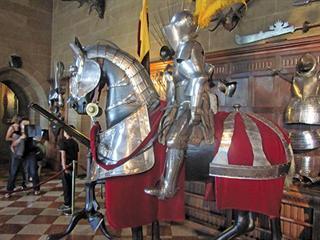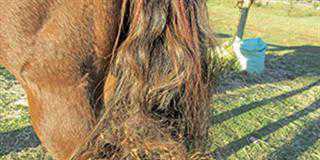
Modern jousting is based on the mediaeval sport. In the Middle Ages, when heavily-armoured knights used lances in warfare, jousting was a way of honing these skills. As is well-known, this involved two horsemen galloping full tilt at each other, seeking to shatter a blunted lance or unseat their opponent. Although practised in various forms since then, competitive jousting was officially ‘reinstated’ in the late 1970s. Potentially one of the most dangerous of equestrian sports, it has captured the interest of the public and has even been shown on TV sports channels.
It has also become a tourist attraction, with jousting contests held at historic castles in Britain and mediaeval theme parks in the USA. Many riders are martial arts experts with an interest in mediaeval weapons and are employed by the film industry as extras for battle scenes in movies.Crossbred Draught Horses are used. These are smaller and more agile than their mediaeval counterparts. In the USA, they appear to be Quarter Horses crossed with Belgians, Friesians or Percherons.
Safety first
The International Jousting Association governs the sport. Horse and rider safety are paramount. Authenticity is the next important factor, with many of the rules governing the sport gleaned from contemporary documents. Furthermore, jousters and their horses are required to wear authentic armour from the period, albeit modified to meet modern safety criteria.
It is fascinating to see how the pieces that made up traditional armour have been ‘converted’ using modern materials.
A padded undergarment, or ‘aketon’, protects the chest and arms – and prevents chafing.
A chainmail hauberk is worn over this, covering the body from just below the chin to mid-thigh, and extending down both arms to the wrists. A metal breastplate protects the chest. Cuisses (padded trousers) protect the upper leg, and thick leather gauntlets the hands. The helmet covers the whole face and throat, and is well-padded.
All steel plates must be of a certain thickness and able to withstand the impact of a lance. The saddle is high in front to protect the abdomen and groin and help riders to withstand the impact of a hit. Shields are made of wood, as they were in the Middle Ages, but shaped to prevent injury should a rider fall. The lance is carved from hardwood dowelling and has a balsa-wood tip which shatters easily.
Entering the lists
Tournaments are held in a 40m-long arena, with riders racing towards each other down a stretch of ground called a ‘list’.
The modern surface is thick sand, to assist in breaking a rider’s fall when he is unseated. A thick cotton rope is attached to wooden poles planted every 2m down the centre, to prevent horses colliding or lances striking dangerously low. Ropes are also strung on the outer edge of the list so that horses effectively gallop down a ‘corridor’ and cannot swing out.
Can adventurous SA riders learn to joust and take part in competitions or films? Yes – if they go overseas, where regular clinics are held. Beware, though. This is not a sport for amateurs, or ‘weekend warriors’.












